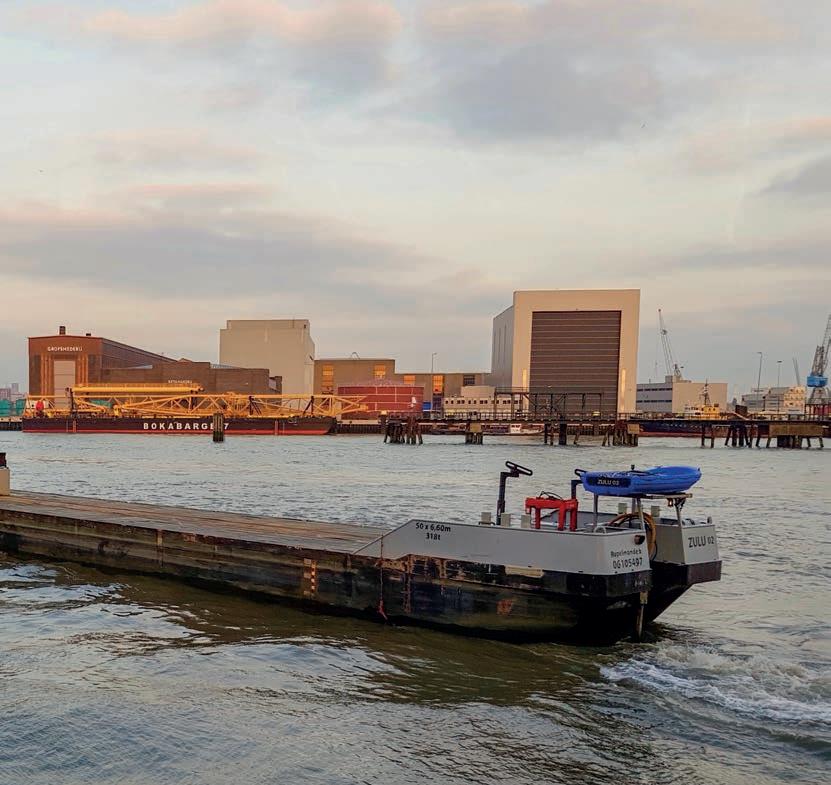
4 minute read
Logistics: momentum for a modal shift for retail
Momentum for modal shift for retail
‘W e need to focus fully on logistics real estate at multi-modal transport hubs,’ says Antoon Van Coillie, CEO of Blue Line Logistics, an innovative player in inland navigation. Cross docks on the edge of cities enable goods to be easily transferred from a barge to, for example, cargo bikes or small zero-emission vans.
Advertisement
Belgium, with the port of Antwerp as a driving force, is one of the most attractive logistics hubs in Europe. Today lorry drivers are currently spending 44 hours per year sitting in tra ic jams. Despite major infrastructure work, no immediate improvement is in sight. According to the Federal Planning O ice, the volume of freight tra ic will increase by 27 percent over the next twenty years. That means even more gridlock on the roads. So why are we not looking for alternatives? Rail, and our rivers and canals, for example.
Belgium has 1076 kilometres of navigable waterways. And across Europe as a whole, there are 25,000 kilometres of navigable waterways connecting the main industrial centres. The major players in the logistics and transport sector are increasingly making the connection that they need to consider complementarity between modes. A sustainable and intelligent mix of transport in which freight is no longer transported solely by road but also by rail or via inland waterways.
Cheap, sustainable and on time Inland navigation is on the rise, Flanders is catching up fast. Never before so much freight has been transported via rivers and canals in Belgium. In the
Q2/2018 alone, Belgian barges transported over 52 million tonnes of goods on the inland waterways. That is an increase of over 5 percent compared with the same period in the previous year.
This success can also be seen in the logistics real estate sector. A market analysis by CEUSTERS shows that more businesses are looking for a warehouse near a waterway. CEUSTERS is encouraging this trend and considers it as a possible solution for the growing tra ic jams on our motorways. ‘It is good that Belgian inland navigation is experiencing this advance. Especially since the tra ic jams are not getting any shorter, nor is there any decline in home deliveries of parcels. Moreover, inland navigation is cheaper, more energy e icient and more punctual than road transport. Undoubtedly it is one of the solutions to the growing

containers and pallets and bulk freight, that we can also load and unload without a crane. That is a revolution in the world of inland navigation, which is still very traditional. We are moving away from the skipper who travels the waterways with his family. He is becoming just an operator working in shifts.’
traic jams,’ says Ingrid Ceusters, CEO of CEUSTERS. The number of warehouses near waterways is growing, say experts. Figures from Flemish Waterways show that there are already 534 industrial sites along or near a waterway in Flanders alone, accounting for a total of 31,830 hectares. The largest site is 5325.28 square metres, the smallest just 900 square metres. More and more businesses - both large multinationals and Belgian companies - are on the look-out for logistics centres near sites by a waterway. ‘Look at the Kluizendok in Ghent, Trilogiport in Liège or Blue Gate in Antwerp. Those are large industrial sites by the water,’ continues Christophe Wuyts, Head of Industrial Agency at CEUSTERS. ‘A good example of a distribution centre that is supplied almost exclusively by water is Nike’s European distribution centre in Laakdal.’
‘The global player opened a new complex in May 2016 that is used both for e-commerce and for deliveries to the retail sector and wholesalers in 38 countries in Europe and Asia. Almost 99 percent of containers in total arrive by water, which means there are 14,000 fewer lorries on the road each year. A ship with a load capacity of 1200 tonnes can quickly transport as much as fifty lorries can,’ Wuyts clarifies.

Cross docks on the edge of town Antoon Van Coillie disputes that shipping is only of interest to transport containers and bulk freight over long distances. ‘Blue Logistics developed the Zulu to cut costs. This is a flexible, flat-bottomed vessel that we can use to transport both
If the last mile is to be served by ship, we need to invest in cross docks on the edge of cities. ‘You can transfer goods easily there, to cargo bikes or small zero-emission vans’ says Van Coillie. He is fully focused on innovation. ‘Digitalisation allows you to see exactly where your goods are. And in the near future it will even be possible for vessels to operate without a helmsman. We will be making unmanned passages to the UK in four years.’ ‘In Flanders we owe our centuries of wealth to our waterways. It would be a shame not to use that infrastructure. For real estate developers, there are great opportunities by our rivers and canals. However, we must be careful not to look at it with rose-coloured glasses. Large-scale residential projects are more lucrative in the short term. And there is increasing demand for recreational cycle paths along the water, but that then cripples the opportunity for urban logistics over the water, a mode for which the potential has far from been exhausted. Also in the Netherlands, the potential is increasingly being discovered. In September, entrepreneurs Wim Beelen and Robert van der Wallen announced that they are pumping EUR 160 million into a logistics centre on the North Sea Canal. The Amsterdam Logistic Cityhub will be a 125,000 square metre hall from where they want to organise sustainable delivery by water of parcels, building materials and hotel and restaurant supplies.




